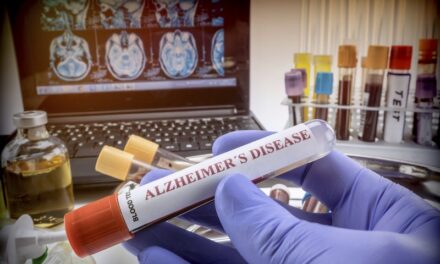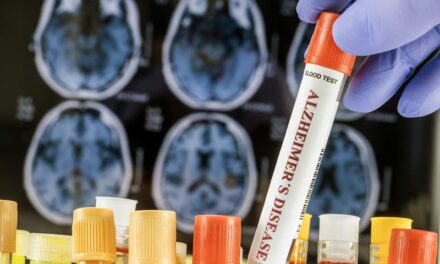Alzheimer’s disease poses numerous diagnostic challenges for clinicians, but new approaches and technologies are providing an array of tools to identify the disease in its earliest stages.
By Adrien Châtillon
The challenges and the diverse ways[1] of diagnosing Alzheimer’s disease have been known for years, but the treatment processes still seem to lag behind, leaving many questions unanswered. That’s why modern researchers, equipped with high-tech resources, hope to discover an easily applicable, accurate way to detect and treat Alzheimer’s before any of the devastating symptoms start manifesting.
Acquiring a holistic perspective, acknowledging the complexity, and understanding the difficulties of diagnosing Alzheimer’s disease is crucial in developing a proper treatment and therapy. But what do the novel, more efficient takes on diagnosis say? Researchers keep highlighting the importance of further studies in this matter, including retinal imaging, eye-scanning, and AI-powered engines used to distinguish subpopulations based on genes architecture or biomarkers.
Acknowledging the Complexity
Standard medical procedures for caring for those afflicted with Alzheimer’s disease often includes checking patients’ medical history, conducting neurologic and psychiatric assessments, and magnetic resonance imaging (MRI) or computed tomography (CT). But this is simply too narrow of an approach, underlining post-factum, irreversible brain changes. The current diagnosis of Alzheimer’s disease relies greatly on measurable symptoms, such as cognitive decline, which means that the disease has already caused severe mental damage, wreaking havoc among brain structures.
Scientists currently are aiming to develop detection methods that track Alzheimer’s disease symptoms as early as possible. Only that way can the patient be treated even before the various molecular mechanisms converge into an irreversible pathway.
It’s never a single factor—mutual influence of lifestyle, genetics, and environment—that predicts the occurrence and progression of Alzheimer’s disease and other neurodegenerative diseases. Studies now confirm that Alzheimer’s disease is heterogeneous in each aspect[2], such as amyloid composition, clinical symptoms, medical history, genetic background, lifestyle, and environment. Therefore, it is nearly impossible to explain Alzheimer’s disease with a precisely defined, single pathological process or variable.
Recently, the U.S. Food and Drug Administration (FDA)[3] announced Accelerated Approval for new drug treatment Aduhelm[4] for patients suffering from the disease. It is based on an amyloid beta-directed antibody, indicated to reduce amyloid deposition in targeted regions of the brain, unfortunately, no clinical change was found in patients. Although it is the first breakthrough since 2003[5] and might set a direction towards discovering underlying Alzheimer’s disease pathophysiology, it is simply not enough—especially as one in three results of conducted clinical trials failed to meet an endpoint.
The FDA is well aware that the need for treatment is urgent, with 6 million Americans living with Alzheimer’s disease, making it the sixth leading cause of death in the U.S., and this number is rapidly growing with a constantly aging population. There’s little doubt that not only significant challenges but also bright perspectives lay ahead for Alzheimer’s disease diagnoses amidst all the resources and brilliant minds combined.
Identifying Diagnostic Biomarkers
Over the years, the study of Alzheimer’s disease has changed from a static, one-sided view of amnestic dementia based on “amyloid hypothesis” to dynamically changing, continuous research on novel possibilities through continuous development of biomarkers analysis and implementation of new technologies.
Why are biomarkers essential yet don’t represent the only key focus in further research? Even though cerebrospinal fluid biomarkers (CSF), amyloid-β (Aβ), and total-tau (tTau) biomarkers are attributed with high diagnostic performance for Alzheimer’s disease detection, their potential remains limited.
The development of tools to measure amyloid-β pathology through analysis to diagnose Alzheimer’s disease first occurred in the 1990s. But, again, a long wait was needed for full standardization of measurement methodology to be completed in this area. A recent validation study introduces Elecsys[6], an in vitro diagnostic immunoassay aiming to identify patients with mild cognitive impairment at risk of progression to Alzheimer’s disease.
Results based on CSF or tTau biomarkers separately can increase the risk of misdiagnosis among patients with other non-Alzheimer’s cognitive dysfunctions, with only pre-symptomatic Aβ pathology.
In order to reduce this misinterpretation, it’s necessary to implement an additional validating factor such as tTau Positron Emission Tomography (PET)[7] and patient’s observation as the reference or develop new pathways of research in blood testing[8] for Alzheimer’s disease diagnosis. Blood testing, in particular, can play a crucial role in facilitating the effective implementation of treatment therapies.
Sporadically, neurofilament light chain protein in CSF (cNfL), a sensitive biomarker of neuroaxonal damage, can reflect disease progression or predict the occurrence of Alzheimer’s disease. There is a visible correlation between increased levels of NfL plasma concentration and Amyloid-β, tTau PET positivity, and magnetic resonance imaging (MRI) that determines progressive neurodegeneration. Although, it’s crucial to mention that it only applies to a narrowed group of patients, as various neurodegenerative changes, in general, may influence NfL levels among older adults.
There is an ethical implication in considering biomarkers as the infallible predictors of Alzheimer’s disease. There’s a thin line between overinterpreting the occurrence of a specific biomarker (which previously was categorized as a predictive factor for Alzheimer’s disease) in the patient’s genetic architecture and not yet visible or measurable symptoms (appearing in patient’s cognitive functions and behaviors).
Challenges concerning biomarker discovery and validation include collection methods, processing procedures, sample storage, and assay standardization within and across laboratories.
Setting the Novel Perspective
Although blood testing for biomarkers seems like a frontrunner in early detection of Alzheimer’s disease, proving to be viable tools for identifying and predicting potential patients, there’s a deep need for additional research.
One emerging technology that should be explored as a means of diagnosing Alzheimer’s disease is retinal imaging. Retinal changes[9] are detectable by using various imaging modalities that reflect neurodegeneration changes or other Alzheimer’s disease-related pathology on a cellular level. The retina can be easily measured through entirely non-invasive imagining technology. Studies show[10] that changes in retinal neuronal layers correspond to cerebral amyloid accumulation, as measured by amyloid PET, in preclinical Alzheimer’s disease. Moreover, retinal scanning might play a role in the pre-cognitive decline in neurodegenerative diseases.
Researchers are defining retinal imaging and eye-scanning[11] as one more layer of data in preclinical recognition of symptoms. Not only could it lower the costs of overall detection of Alzheimer’s disease, but most importantly, it could shorten the valuable diagnostic time and reduce the use of invasive diagnostic methods.
Groundbreaking Risk Factors
A significantly high percentage of patients suffering from Alzheimer’s disease report sleep disturbances from the early symptoms. The more the disease progresses, the more severe and increased sleep deprivation[12]. Focusing on sleep disorders[13] might be a future key predictor of developing early stages of Alzheimer’s disease.
As proactive approaches based on early interventions provide more effective results in preclinical stages, researchers now examine combining Aβ pathology with sleeping disorders. Here, the role of Aβ levels and sleep play a crucial part in detecting this devastating neurodegenerative disease. The increasing importance of this factor is based on the relation between Aβ increased levels, through pathological accumulation causing sleep deprivation. Disturbed sleep routine might be a crucial factor and a signal for future Alzheimer’s disease diagnosis.
What Does the Future Hold?
These days AI-powered algorithms[14] can be programmed to analyze enormous datasets that stay out of reach of human cognition possibilities. They distinguish the subpopulations, narrow biomarkers’ heterogeneity, and indicate similar gene structures of particular diseases.
On top of that, IBM and Pfizer experts state[15] that artificial intelligence could soon help screen for Alzheimer’s disease by analyzing potential patients’ writing decay. Their teams believe that AI-powered engines can be developed in a way to detect early signs of Alzheimer’s disease by examining linguistic patterns in vocabulary, syntax, and overall word usage.
Non-invasive brain stimulation (NIBS) is another alternative diagnostic method. The two most commonly used types of NIBS are transcranial magnetic stimulation (TMS) and transcranial direct current stimulation (tDCS). They have both been proven to have extensive usage, application possibilities, and diverse stimulation parameters.
Although NIBS hasn’t been explicitly proven to be the unambiguous solution to curing Alzheimer’s disease, research results show[16] that TMS provides effective and reliable behavioral effects among patients. The meta study identifies general behavioral improvements, especially when combine NIBS tech solutions with cognitive stimulation. This is seemingly the most promising approach in Mild Cognitive Impairment and Alzheimer’s disease diagnosis and treatment development.
The history of Alzheimer’s disease started in the early twentieth century[17], and it took almost a hundred years to identify the components of pathological trademarks and genetic subtypes to assemble at least some pathogenic criteria[18] of this devastating neurodegenerative disease. Diagnosing and delaying the progression of Alzheimer’s disease through novel technology is a breakthrough that might finally steer treatment development towards more effective, long-term solutions.
About the Author
Adrien Châtillon is the co-founder and CEO of Actipulse Neuroscience, a medical technology company focused on brain health. Based in Boston and present in three countries, Actipulse specializes in non-invasive brain stimulation therapeutics for the treatment of neurological and psychiatric disorders. Adrien has previously co-founded two startups in his native France. He is a polyglot, having lived and worked in more than eight countries.
REFERENCES
[1] https://www.alz.org/alzheimers-dementia/research_progress/earlier-diagnosis
[2] https://www.sciencedirect.com/science/article/pii/S0896627314009581
[3] https://www.fda.gov/drugs/news-events-human-drugs/fdas-decision-approve-new-treatment-alzheimers-disease
[4] https://www.fda.gov/news-events/press-announcements/fda-grants-accelerated-approval-alzheimers-drug
[5] https://www.future-science.com/doi/10.4155/fmc-2019-0310
[6] https://diagnostics.roche.com/global/en/products/params/elecsys-abeta42.html
[7] https://www.embopress.org/doi/full/10.15252/emmm.202114398
[8]https://clpmag.com/disease-states/dementias-alzheimer/prognostic-alzheimers-disease-blood-test-in-symptom-free-stage/
[9] https://alz-journals.onlinelibrary.wiley.com/doi/full/10.1002/alz.12179
[10] https://www.ncbi.nlm.nih.gov/pmc/articles/PMC7259639/
[11] https://medicine.wustl.edu/news/alzheimers-one-day-may-be-predicted-during-eye-exam/
[12] https://onlinelibrary.wiley.com/doi/10.1111/j.1365-2869.1995.tb00145.x
[13] https://www.frontiersin.org/articles/10.3389/fphar.2019.00695/full
[14] https://spie.org/news/artificial-intelligence-based-algorithm-for-the-early-diagnosis-of-alzheimers?SSO=1
[15] https://www.thelancet.com/journals/eclinm/article/PIIS2589-5370(20)30327-8/fulltext
[16] https://www.frontiersin.org/articles/10.3389/fnhum.2020.00179/full
[17] https://www.ncbi.nlm.nih.gov/pmc/articles/PMC3181715/
[18]https://www.radc.rush.edu/docs/var/detail.htm?category=Pathology&subcategory=Alzheimer%27s+disease&variable=niareagansc





